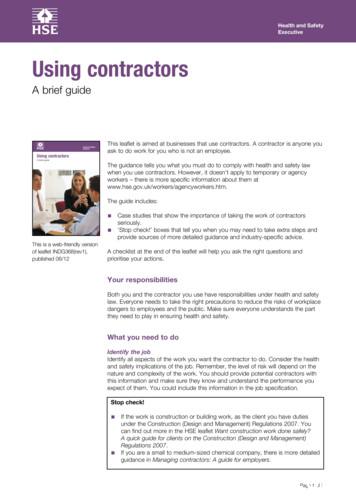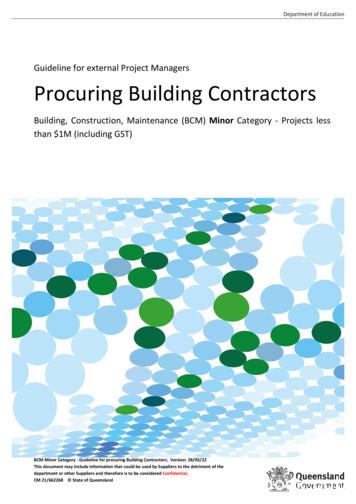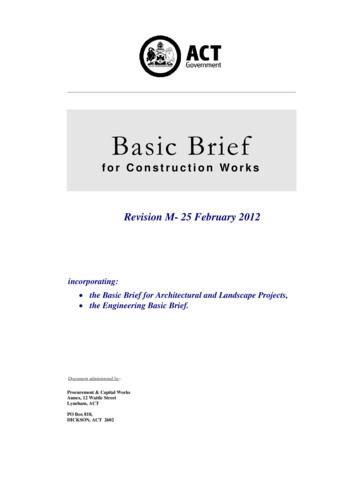Using Contractors: A Brief Guide INDG368(rev1)
Health and SafetyExecutiveUsing contractorsA brief guideUsing contractorsA brief guideThis leaflet is aimed at businesses that use contractors. A contractor is anyone youask to do work for you who is not an employee.The guidance tells you what you must do to comply with health and safety lawwhen you use contractors. However, it doesn’t apply to temporary or agencyworkers – there is more specific information about them atwww.hse.gov.uk/workers/agencyworkers.htm.The guide includes: Case studies that show the importance of taking the work of contractors This is a web-friendly versionof leaflet INDG368(rev1),published 06/12seriously.‘Stop check!’ boxes that tell you when you may need to take extra steps andprovide sources of more detailed guidance and industry-specific advice.A checklist at the end of the leaflet will help you ask the right questions andprioritise your actions.Your responsibilitiesBoth you and the contractor you use have responsibilities under health and safetylaw. Everyone needs to take the right precautions to reduce the risks of workplacedangers to employees and the public. Make sure everyone understands the partthey need to play in ensuring health and safety.What you need to doIdentify the jobIdentify all aspects of the work you want the contractor to do. Consider the healthand safety implications of the job. Remember, the level of risk will depend on thenature and complexity of the work. You should provide potential contractors withthis information and make sure they know and understand the performance youexpect of them. You could include this information in the job specification.Stop check! If the work is construction or building work, as the client you have duties under the Construction (Design and Management) Regulations 2007. Youcan find out more in the HSE leaflet Want construction work done safely?A quick guide for clients on the Construction (Design and Management)Regulations 2007.If you are a small to medium-sized chemical company, there is more detailedguidance in Managing contractors: A guide for employers.Page 1 of 7
Health and SafetyExecutiveSelect a suitable contractorYou will need to satisfy yourself that the contractor you choose can do the jobsafely and without risks to health. This means making enquiries about thecompetence of the contractor – do they have the right combination of skills,experience and knowledge? The degree of competence required will depend onthe work. Similarly, the level of enquiries you make should be determined by thelevel of risks and the complexity of the job.Examples of questions you could ask potential contractors include: What arrangements will you have for managing the work? For example, who will be responsible, how will the work be supervised, what checks do you make onequipment and materials etc?Will you be using subcontractors and if so how will you check they arecompetent? The level of competence for subcontractors will depend on the riskand the complexity of the work.What is your recent health and safety performance? For example, how manyaccidents and cases of ill health have you had, has HSE taken any action takenagainst you?Do you have a written health and safety policy? (This is only a requirement if fiveor more people are employed.)Can you provide existing risk assessments done for similar jobs? Again, writtenrisk assessments are only required by law if five or more people are employed.What qualifications, skills and experience do you have in this type of work?What health and safety information and training do you provide for yourworkers?If required, do you have Employers’ Liability Compulsory Insurance?These questions will help you find out whether the contractor is complying with theirduties under health and safety law. You can then decide how much evidence isneeded to support what you have been told.Other questions you can ask which may help you to decide which contractor tochoose include: Do they have any independent assessment of their competence? Are they members of a trade association or professional body? Will they be producing a safety method statement for the job? A safety methodstatement is not required by law. It does however describe in a logicalsequence exactly how a job is to be carried out in a safe manner and withoutrisks to health. It includes all the risks identified in the risk assessment and themeasures needed to control those risks. This allows the job to be properlyplanned and resourced.Case studyA tree surgeon was felling a branch, when it fell into a neighbouring garden,damaging a fence panel. An hour earlier the neighbour had been in the gardenplaying with her 20-month-old child. The tree surgeon had neither thequalifications to use a chainsaw nor the skill to carry out the job safely. If theproperty developer who hired the tree surgeon had checked that he wascompetent to carry out the work, this incident would have been avoided. Don’tassume someone is competent, check it yourself.Using contractors: A brief guidePage 2 of 7
Health and SafetyExecutiveAssess the risks of the workBoth you and the contractor need to think about the planned work: What can harm people? Who might be harmed and how? How will you control the risks?You can find more detailed information on risk assessment and control atwww.hse.gov.uk/risk/index.htm.You should already have a risk assessment for the work activities of your own business.Make sure your assessment covers risks to contractors from your business (egasbestos, on-site vehicles). The contractor must assess the risks for the contractedwork and then both of you must get together to consider any risks from each other’swork that could affect the health and safety of the workforce or anyone else.You need to think about any risks to your workers and members of the public,because you have contractors on site. Also, make sure you agree the measuresneeded to control risk with the contractor before work starts.Stop check! Include health risks, such as high levels of noise or exposure to harmful substances, as well as safety risks.Once you have agreed action to control risks, be clear about who will do whatand when. An easy way to communicate and record your findings is to usethe risk assessment template plate.doc).There are specific requirements for some higher risk workplaces. For moreinformation go to HSE’s industries pages at www.hse.gov.uk/guidance/industries.htm.Case studyA worker was killed when she was run over by a vehicle operated by a contractor.Neither the employer nor the contractor had identified pedestrian routes to keeppedestrians separate from moving vehicles. Additionally, the contractor hadn’tgiven his drivers adequate training to make sure they operated the vehicles safely.The employer should have identified risks from the contractor being on site andagreed measures to control those risks before the work started.Provide information, instruction and trainingYou and the contractor need to communicate with each other throughout theprocess. Make sure that the contractor and their employees have information on: health and safety risks they may face; measures in place to deal with those risks; your emergency procedures.The information you provide should be in a form that is easy to understand.Similarly, you must provide clear instructions, information and adequate training foryour own employees.Using contractors: A brief guidePage 3 of 7
Health and SafetyExecutiveStop check! For more advice, see HSE’s leaflet Health and safety training: What you need to know.Pay particular attention to those whose first language may not be English –see HSE’s migrant workers web pages for more information, atwww.hse.gov.uk/migrantworkers.Case studyA farm worker received internal injuries and severe burns from electric shockwhen he lifted an irrigation pipe and it contacted 33 000 V overhead power lines.The employer had not discussed the presence of the overhead lines andidentified a safe way of moving the irrigation pipes. The employer should havemade the contractor aware of the risks he faced and agreed a method of workbefore the job was started. Don’t assume that contractors will be aware of allrisks, even if they seem obvious to you.Cooperate and coordinate with the contractorYou and the contractor must work together and coordinate your activities, to makesure the work can be done safely and without risks to health. One way of doing thisis to have regular meetings throughout. The level of cooperation and coordinationneeded will depend on: the job to be done; the number of contractors (or subcontractors) involved; the risks involved.Case studyA delivery driver was injured when a lift truck hit him as he walked into a factoryto find out where he should deliver his load. The employer should have identifiedthe risks to the driver and given him clear instructions.Consult the workforceYou have to consult your employees on health and safety matters. Involving yourworkers will help you make better decisions on the actual risks and the measuresto control them. Involve your workers in the process and consult them on: how the contractor’s work will affect their health and safety; information and training; making sure they know how to raise any concerns they may have about thecontractors and their work.Case studyA contractor working at a newsprint firm had his leg amputated when it wastrapped in machinery. He had climbed onto the conveyor to move a reel thatwas stuck and his leg was caught between the roller and the moving slattedmetal conveyor. The employer should have identified the risks from the work andprovided a safe system of carrying it out. If the employer had consultedemployees, this method of working would have been identified and controls putin place to prevent the accident.Using contractors: A brief guidePage 4 of 7
Health and SafetyExecutiveManage and supervise the workDecide what you need to do to manage contractors’ work. The measures you putin place should be consistent with the level of risk, ie the greater the risk, the moreyou need to do.Consider: Who will be responsible for the work and what do you expect them to do? Who will supervise the work and how? How will the work be done and what precautions will be taken? What equipment should or should not be worked on/used? What personal protective equipment is to be used and who will provide it? What are the working procedures, including any permits-to-work? What are the arrangements for stopping the work, if there are serious healthand safety concerns?Once the work has started, make sure you keep a check on how the work is goingagainst what you have agreed. You can do this by: regular checks – ask yourself ‘are the control measures working?’ investigating if things go wrong, eg near misses, accidents, ill health. Askyourself ‘what went wrong and what can we do to prevent it happening again?’After the job is finished, there will be benefits in reviewing and learning from anylessons to see if performance can be improved in future.Case studyContractors were employed to install new guttering on a 7 m high building. Theworkers could get onto the roof from a mobile tower at the front of the building,but there wasn’t any equipment to stop them falling at the back where work wastaking place. The employer should have made a decision about how the workwould be carried out, what equipment would be used and who would supply itbefore work started. Don’t assume that the contractor will have the rightequipment to carry out the job safely.Stop check!This guide provides basic information on managing health and safety when usingcontractors. Further guidance on managing health and safety can be found inSuccessful health and safety management.Using contractors: A brief guidePage 5 of 7
Health and SafetyExecutiveChecklistQuestions you should ask:Yes/NoHave you identified all aspects of the work you want the contractor to do?Have you included the health and safety implications of the work in the job specification?Is the work construction or building work? If so, do you know what more you need to do tocomply with the Construction (Design and Management) Regulations 2007?Have you made enquiries about the competence of the contractor? If so, have youchecked for evidence before they get the job?Have you assessed the risks of the work and agreed action to control the risks with thecontractor?Have you provided the contractor and their employees with information about the risks?Have you provided the contractor and their employees with your emergency procedures?Have you provided instructions, information and training for your own employees?Have you put in place arrangements with the contractor to coordinate your activities duringthe work?Have you consulted your employees about the work and how they can raise any concerns?Have you identified who will be responsible for the work and what you will expect themto do?Have you identified who will supervise the work and how?Have you put in place arrangements to keep a check on how the work is going againstwhat you have agreed with the contractor?Have you agreed how the job will be reviewed to learn any lessons from it?Using contractors: A brief guidePage 6 of 7
Health and SafetyExecutiveWant to know more?Consulting workers on health and safety: Safety Representatives and SafetyCommittees Regulations 1977 (as amended) and Health and Safety (Consultationwith Employees) Regulations 1996 (as amended). Approved Codes of Practice andGuidance (Second edition) L146 HSE Books 2012ISBN 978 0 7176 6461 0 www.hse.gov.uk/pubns/books/l146.htmHealth and safety training: A brief guide Leaflet INDG345(rev1)HSE Books 2012 www.hse.gov.uk/pubns/indg345.htmManaging contractors: A guide for employers HSG159 (Second edition) HSE Books2011 ISBN 978 0 7176 6436 8 www.hse.gov.uk/pubns/books/hsg159.htmManaging health and safety in construction. Construction (Design andManagement) Regulations 2007. Approved Code of Practice L144 HSE Books2007 ISBN 978 0 7176 6223 4 www.hse.gov.uk/pubns/books/l144.htmSuccessful health and safety management HSG65 (Second edition) HSE Books1997 ISBN 978 0 7176 1276 5 www.hse.gov.uk/pubns/books/hsg65.htmWant construction work done safely? A quick guide for clients on the Construction(Design and Management) Regulations 2007 Leaflet INDG411 HSE Books 2007www.hse.gov.uk/pubns/indg411.pdfFor more information about risk assessment, see www.hse.gov.uk/risk/index.htmFurther informationFor information about health and safety, or to report inconsistencies or inaccuraciesin this guidance, visit www.hse.gov.uk/. You can view HSE guidance online andorder priced publications from the website. HSE priced publications are alsoavailable from bookshops.This guidance is issued by the Health and Safety Executive. Following the guidance isnot compulsory, unless specifically stated, and you are free to take other action. But ifyou do follow the guidance you will normally be doing enough to comply with the law.Health and safety inspectors seek to secure compliance with the law and may refer tothis guidance.This leaflet is available in priced packs from HSE Books, ISBN 978 0 7176 6467 2.A web version can be found at www.hse.gov.uk/pubns/indg368.pdf. Crown copyright If you wish to reuse this information visit www.hse.gov.uk/copyright.htm for details. First published 03/13.Published by the Health and Safety Executive03/13INDG368(rev1)Page 7 of 7
A worker was killed when she was run over by a vehicle operated by a contractor. Neither the employer nor the contractor had identified pedestrian routes to keep pedestrians separate from moving vehicles. Additionally, the contractor hadn’t given his drivers adequate training to make sure they operated the vehicles safely. The employer should have identified risks from the contractor being .
238160 Roofing Contractors . 238170 Siding Contractors . 238190 Other Foundation, Structure, and Building Exterior Contractors . 238210 Electrical Contractors and Other Wiring Installation Contractors . 238220 Plumbing, Heating, and Air-Conditioning Contractors . 238290 Other Building Equipment Contractors . 238310 Drywall and Insulation .
contractors, with a minimum of three (3) " local" contractors invited with the Regional Infrastructure Advisor / manager involved in the process of determination. For values between 500,000 and 1,000,000 the works are to be offered to a minimum of five (5) "local" contractors, with a minimum of three (3) " local" contractors.
Contractors and suppliers need to engage with both Thames Water and each other to ensure we are able to achieve these aims. 1.3 Objectives Contractors should develop their own objectives which support the delivery of our aims. Thames Water will work collaboratively with contractors to achieve them. Contractors must monitor the delivery
The Project Brief can take two forms: A letter Brief may be used for projects less than 100,000 (total cost including GST and fees). Full Brief utilising a project specific brief with this Basic Brief. The Project Brief in its dra
Non-Registered Contractors and Accreditation for Skilled Construction Workers and Construction Site Supervisors S/NO TYPE OF APPLICATION KENYAN CONTRACTORS (KShs.) FOREIGN CONTRACTORS (US ) A 1. New application 5,000.000 500 2. Up-grading class of Con
2. arizona registrar of contractors Database The Arizona Registrar of Contractors (ROC) is a state administrative body that regulates and licenses contractors. The ROC has established minimum workmanship standards to which contractors must adhere. The ROC website, www.azroc.gov, has a link
(HPSCI), the Senate Select Committee on Intelligence (SSCI), and other committees that may have an interest in this topic. The Intelligence Community and Its Use of Contractors: Congressional Oversight Issues . federal civilian employees, military personnel, and contractors. The section titled "Contractors
A 15-member board appoints CSLB's executive officer, or registrar of Contractors, and directs administrative policy for the agency's operations. This appointed board includes nine public members (eight non-contractors and one local building official), five contractors, and one labor representative. The Governor makes eleven appointments























